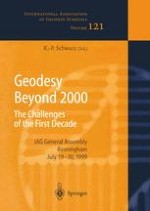2000 | OriginalPaper | Buchkapitel
Wavelets and collocation: An interesting similarity
verfasst von : Christopher Kotsakis
Erschienen in: Geodesy Beyond 2000
Verlag: Springer Berlin Heidelberg
Enthalten in: Professional Book Archive
Aktivieren Sie unsere intelligente Suche, um passende Fachinhalte oder Patente zu finden.
Wählen Sie Textabschnitte aus um mit Künstlicher Intelligenz passenden Patente zu finden. powered by
Markieren Sie Textabschnitte, um KI-gestützt weitere passende Inhalte zu finden. powered by
The rapid developments in the fields of multiresolution appro-ximation theory and wavelets over the past few years have created an enormous amount of important theoretical knowledge and useful practical tools to be used for various signal processing applications. One of the most attractive properties of multiresolution/wavelet theory is the ability to study the details of a signal locally in various scale levels, according to azoom-in/zoomout approach. In gravity field modelling, on the other hand, we are used to employing (both theoretically and practically) the concept of collocation in order to approximate and study the behavior of unknown signals based on discrete data. One of the standard formulations of collocation, as a spatio-statistical linear approximation problem in purely deterministic fields, requires the use of a covariance function which is defined via a certain spatial averaging operator over the signal’s domain. The “stationary” form of this CV function is often thought to provide strong limitations in the approximation framework, because the actual behavior of the gravity field is “non-stationary”. The aim of this paper is to show that there does not really exist any “signal stationarity restriction” problem in statistical collocation, since it can be proven to be equivalent to a wavelet-type expansion. The connection between the two concepts is discussed, and also some recommendations for further work are given
